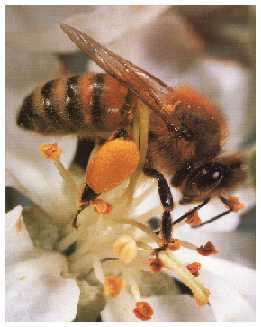Home Classes Products Educational Videos Pollen Links Disease & Pests
A-Bee Honey
Classes
|
Dealing with an Africanized Bee Hive
Removing brood and giving it to another hive Catching a Swarm that is Leaving: Bee Swarm That Was Leaving Part 2 Lighting a smoker the quick and easy way One Step Towards Swarm Prevention
________________________________________________
Online
5 new classes have been added
This is a video about a Top Bar Hive that has turned aggressive.
It is moved to a remote location and the honey and brood removed and
the hive prepared to be converted to a Langstroth Hive and given a
new queen.
This is a continution of Part 1. We
cannot find the queen so a queen excluder is attached to the bottom
of the super, elevated and the bees shaken in front of the hive.
We are preparing it to receive a new queen. This is a continution of Part 1 & 2.
We have prepared the hive it to receive a new queen. A queen
is not available so we have taken a frame of eggs and young larva
from a 2012 Carniolan Breeder queen and will insert it in the brood
nest and then give the hive a 50/50 sugar water to help it get
started.
Cornell University
E.F. Phillips Beekeeping
Library
ELAP Emergency
Assistance for Honeybee
Loss
505-286-4843
We accept checks,
Zelle, Venmo and major
credit cards
How Packaged Bees Are Produced
Honey
Our
honey is produced in various yards throughout NM and Colorado.
Our primary yards
are in Albuquerque, Belen, Corrales, Edgewood, Las Cruces, Los Lunas, Alcalde and Taos
Bumble bees, yellow jackets paper wasps, ground nesting bees and honey bees
Again
for 2024:
Honey and bee pollen by zip code in Albuquerque and surrounding
area. Click here for more information.
Where to
Buy Honey & Pollen by Zip Code
Educational Videos
Where we get the Lumber for the Products we make
Feeding and Adding Supers for Expansion of the Brood Nest (Chamber)
Drone Comb Removal to Reduce Varroa Mites
Inspecting a hive that was formerly a Tear Out
Educational Papers
Supplemental Feeding of Honey Bee Colonies
A Descriptive Study
|
Beekeeping Classes are forming now. The next class will be Sunday January 25th 2026 beginning at 11:00 AM and will include an IHOP style brunch. Brunch will include scrambled eggs, hashbrowns, turkey sausage and pancakes. This allows us to feature our various honey varieties. Classes are by reservation only. They are held to a maximum of 52 attendees. Cost is $15.00 per person. You will receive an IHOP style brunch, class instruction and a pint of honey of your choice. No children under the age of 13 please. Each class will run for 45 minutes with a 15 minute break. Classes will cover: Beginning with bees Where to get honeybees Building a honey and bee business How to rapidly expand your business Address: 4927 Prospect NE, Albuquerque. Go to north side of building. Make reservations by sending a text to: 505-688-6210
Orders are taken by phone: 505-286-4843 (click here to order by email) We accept checks, Zelle, Venmo and major credit cards
REFUND POLICY We do not offer refunds on orders of package bees, nucs or nucs in a hive . If you are not able to pick up your bees or accept delivery we will continue to hold the bees for you in a nuc or a single hive until a time when you can take receipt of them. If you are transferring your order to another person please send us a notice of transfer. Remember that PACKAGED BEES, QUEENS, Nucs and Hives is dependent on WEATHER and other factors which are out of our control.
Orders are taken by phone: 505-286-4843
We accept checks, Zelle, Venmo and major credit cards
|
